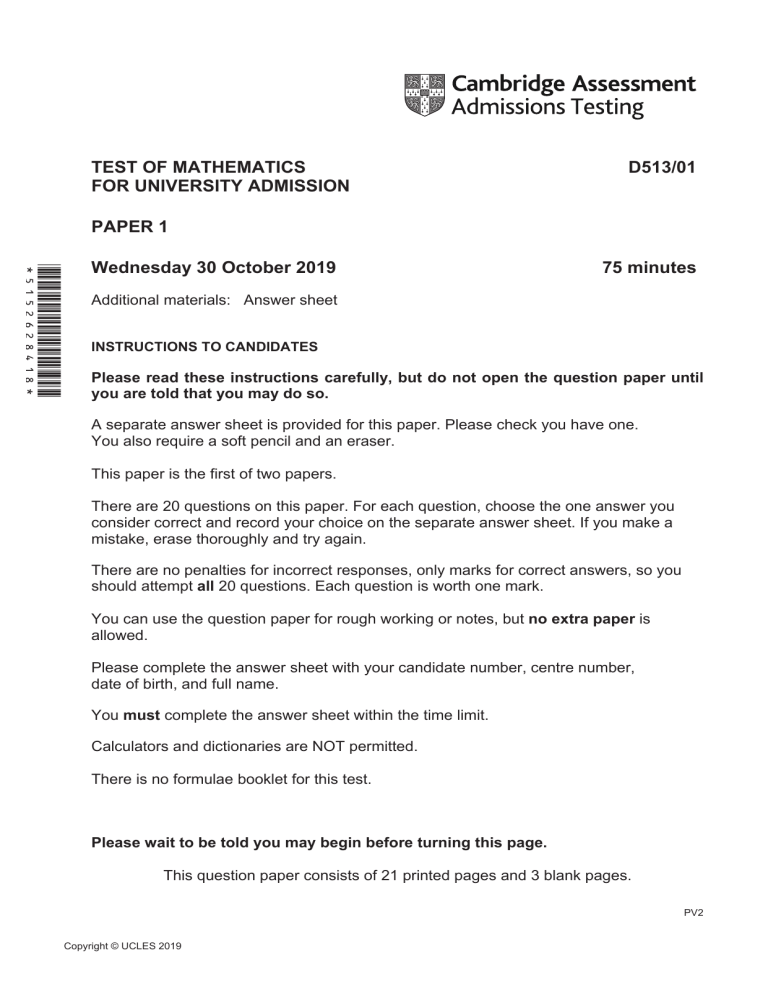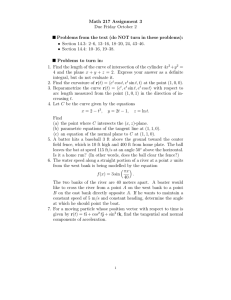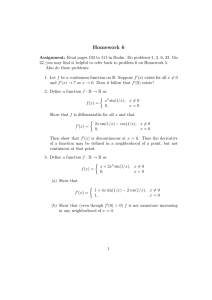
TEST OF MATHEMATICS FOR UNIVERSITY ADMISSION D513/01 PAPER 1 Wednesday 30 October 2019 75 minutes Additional materials: Answer sheet INSTRUCTIONS TO CANDIDATES Please read these instructions carefully, but do not open the question paper until you are told that you may do so. A separate answer sheet is provided for this paper. Please check you have one. You also require a soft pencil and an eraser. This paper is the first of two papers. There are 20 questions on this paper. For each question, choose the one answer you consider correct and record your choice on the separate answer sheet. If you make a mistake, erase thoroughly and try again. There are no penalties for incorrect responses, only marks for correct answers, so you should attempt all 20 questions. Each question is worth one mark. You can use the question paper for rough working or notes, but no extra paper is allowed. Please complete the answer sheet with your candidate number, centre number, date of birth, and full name. You must complete the answer sheet within the time limit. Calculators and dictionaries are NOT permitted. There is no formulae booklet for this test. Please wait to be told you may begin before turning this page. This question paper consists of 21 printed pages and 3 blank pages. PV2 Copyright © UCLES 2019 BLANK PAGE 2 1 f(x) is a quadratic function in x. The graph of y = f(x) passes through the point (1, −1) and has a turning point at (−1, 3). Find an expression for f(x). A −x2 − 2x + 2 B −x2 + 2x + 3 C x2 − 2x D x2 + 2x − 4 E 2x2 + 4x + 1 F −2x2 − 4x + 5 3 2 Find the complete set of values of the real constant k for which the expression x2 + kx + 2x + 1 − 2k is positive for all real values of x. A −12 < k < 0 B k < −12 or k > 0 √ √ C − 6−3<k < 6−3 √ √ D k < − 6 − 3 or k > 6 − 3 E −2 < k < 1 2 F k < −2 or k > 1 2 G 0<k<4 H k < 0 or k > 4 4 3 Find the coefficient of x in the expression: (1 + x)0 + (1 + x)1 + (1 + x)2 + (1 + x)3 + · · · + (1 + x)79 + (1 + x)80 A 80 B 81 C 324 D 628 E 3240 F 3321 G 6480 H 6642 5 4 The sequence xn is given by: x1 = 10 xn+1 = √ xn for n ≥ 1 What is the value of x100 ? c c [Note that ab means a(b ) ] A 102 99 B 102 100 C 102 −99 D 102 −100 E 10−2 99 F 10−2 100 G 10−2 −99 H 10−2 −100 6 5 S is a geometric sequence. The sum of the first 6 terms of S is equal to 9 times the sum of the first 3 terms of S. The 7th term of S is 360. Find the 1st term of S. A 40 27 B 40 9 C 40 3 D 45 16 E 45 8 F 45 4 7 6 The circles with equations (x + 4)2 + (y + 1)2 = 64 and (x − 8)2 + (y − 4)2 = r2 where r > 0 have exactly one point in common. Find the difference between the two possible values of r. A 4 B 10 C 16 D 26 E 50 8 7 A curve has equation y = (2q − x2 )(2qx + 3) The gradient of the curve at x = −1 is a function of q. Find the value of q which minimises the gradient of the curve at x = −1. A −1 B − 34 C − 12 D 0 E 1 2 F 3 4 G 1 9 8 The function f is such that 0 < f(x) < 1 for 0 ≤ x ≤ 1. The trapezium rule with n equal intervals is used to estimate produces an underestimate. 1 0 f(x) dx and Using the same number of equal intervals, for which one of the following does the trapezium rule produce an overestimate? A B C D E 1 0 1 0 (f(x) + 1) dx 2f(x) dx 0 −1 0 −1 1 0 f(x + 1) dx f(−x) dx (1 − f(x)) dx 10 9 p is a positive constant. √ √ Find the area enclosed between the curves y = p x and x = p y A 2 52 p 3 − 12 p2 B 4 52 p 3 − p2 C p4 6 D p4 3 E 2 3 p 3 − 12 p4 F 4 3 p 3 − p4 G 2p4 11 10 Evaluate 3 −1 A |x|(1 − x) dx 17 3 B − 17 3 C 16 3 D − 16 3 E 11 3 F − 11 3 12 11 Find the sum of the real values of x that satisfy the simultaneous equations: log3 (xy 2 ) = 1 (log3 x)(log3 y) = −3 A 1 3 B 1 C 3 D 3 19 1 E 9 27 F 9 13 G 27 H 27 19 13 12 It is given that dV 24π(t − 1) √ for t ≥ 1 = dt (1 + t ) and V = 7 when t = 1. Find the value of V when t = 9. A 208π + 7 B 216π + 7 C 224π + 7 D 416π + 7 E 608π + 7 F 744π + 7 14 13 Find the maximum value of 4sin x − 4 × 2sin x + for real x. A 1 4 B 5 2 C 13 2 D 21 2 E 65 4 F There is no maximum value. 15 17 4 14 x satisfies the simultaneous equations sin 2x + and √ √ 3 cos 2x = −1 3 sin 2x − cos 2x = where 0◦ ≤ x ≤ 360◦ . Find the sum of the possible values of x. A 210◦ B 330◦ C 390◦ D 660◦ E 780◦ F 930◦ 16 √ 3 15 Find the real non-zero solution to the equation x 2(9 ) 1 x) = (3 8 4 A log3 2 B 2 log3 2 C 1 D 2 E log2 3 F 2 log2 3 17 16 Given that 1 2 f(x) dx + 5 0 and 2 f(x) dx = 14 1 1 f(x + 1) dx = 6 0 find the value of 2 f(x) dx 0 A −8 B −4 C −2 D 2 E 4 F 29 5 G 32 5 H 14 18 17 Find the fraction of the interval 0 ≤ θ ≤ π for which the inequality sin(2θ) − 12 sin θ − cos θ ≥ 0 is satisfied. A 1 12 B 1 6 C 1 4 D 5 12 E 7 12 F 3 4 G 5 6 H 11 12 19 18 Find the shortest distance between the curve y = x2 + 4 and the line y = 2x − 2. A 2 √ 5 B C √ 6 5 5 D 3 E √ 5 5 3 F 5 G 6 20 19 Find the value of 90 sin(10 + 90k)◦ k=0 A 0 B sin 10◦ C sin 100◦ D sin 190◦ E sin 280◦ F 1 21 20 What is the complete range of values of k for which the curves with equations y = x3 − 12x and y = k − (x − 2)2 intersect at three distinct points, of which exactly two have positive x-coordinates? A −4 < k < 0 B −4 < k < 4 C −4 < k < 16 D −16 < k < 0 E −16 < k < 4 F −16 < k < 16 22 BLANK PAGE 23 BLANK PAGE 24



